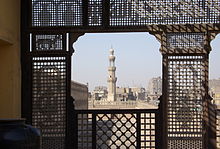Gayer Anderson Museum
The Gayer-Anderson Museum is a museum in Cairo (Egypt) with the themes of traditional Islamic home decor, architecture , art , archeology and curiosities . It is named after the British medical officer Major Robert Grenville (also "John") Gayer-Anderson Pascha, who lived in the house from 1935 to 1942 with a special permit from the Egyptian government and furnished it with traditional furniture, carpets and artifacts and works of art that he had collected and furnished curios. The building, the main parts of which were erected in the 16th and 17th centuries, is structurally based on the world-famous Ibn Tulun mosque from the 9th century AD.
The building parts
The present museum building consists of two old residential buildings.
- The oldest building was built by Hajj Mohammad Ibn Al-Hajj Salem Ibn Galman al-Gazzar in 1540. It was called "Beit Amna bint Salim" by the population after the later owner Amna bint Salim al-Gazzar.
- The younger building was built by the wealthy merchant Abd al-Qadir al-Haddad in 1670. It was later acquired by a lady from Crete and therefore also called "Beit el-Kretliyya", the "House of the Cretan", a name that was later to be transferred to the entire ensemble.
Both buildings belonged to the residential development that had spread over the centuries in the area of the "Gebel Yashkur" (today Sayyida Zeinab) and had grown up to the mosque of Ibn Tulun. At the beginning of the 20th century, the walls of the mosque were therefore practically invisible.
In the course of efforts to make the Islamic monuments in Cairo more accessible, the Egyptian government began in 1928 to demolish the residential buildings around the Ibn Tulun mosque. The “Committee for the Conservation of Arab Monuments” opposed the demolition of the “Beit el-Kretliyya” because this semi-detached house was much better preserved than other buildings around the mosque. This ensemble was preserved and the side walls reinforced so that the building could remain standing even after the neighboring houses were demolished.
The namesake
The Briton of Irish descent Robert Grenville (also "John") Gayer-Anderson (1881-1945) had completed his medical studies in England in 1903 and was drafted into the Royal Army Medical Corps as a medical officer the following year. In 1906 he was posted to the Egyptian Army , where he worked, among other things, as a recruiting officer. His love for Egyptian culture developed during his time in the army and probably later as Oriental Secretary to the High Commissioner.
His last British rank was a major . After his retirement in 1924, RG Gayer-Anderson lived in Cairo and continued to collect. Later he was appointed "Lewa" ( Major General ) by the Egyptian King Faruq and received the honorary title of Pasha .
In 1935, RG Gayer-Anderson received permission to move into the renovated building next to the Ibn Tulun Mosque. He continued to work on modernizing the building complex and had electricity and utility lines installed. He also repaired the wells and the pavement around the house.
During this time he continued to work on expanding his art and antiques collection, some of which he exhibited in-house. In addition, he furnished the house with traditional furniture and carpets. The house became more and more of a museum.
In 1942 he returned to England for health reasons and handed over his house in Cairo with the furnishings and part of the collection to the Egyptian government. In England he and his identical twin brother Colonel Thomas Gayer-Anderson, who was also an avid collector of Egyptian antiquities, had a house in Lavenham , Suffolk, called "Little Hall". In 1943 the brothers bequeathed the majority of their ancient Egyptian antiques, around 7,500 pieces in total, to the Fitzwilliam Museum in Cambridge. A room in the "Egyptian Galleries" of the museum was named after the brothers, the "Gayer-Anderson Room".
In 1945 Robert Grenville Gayer-Anderson died.
In 1947, the ancient Egyptian bronze statue of a cat arrived at the British Museum in London, which RG Gayer-Anderson had given to the museum in 1939. This work of art caused a sensation at the time and is still known today as the "Gayer-Anderson Cat". A copy is now in the Gayer-Anderson Museum in Cairo.
The building as a museum
Wall niche with handicrafts and muqarnas decoration
The building complex in Cairo is now open to tourists as a museum and can be visited for a fee. It is operated by the Supreme Council of Antiquities , the highest Egyptian monument preservation authority. The museum entrance is between the outer and inner perimeter walls near the main entrance of the Ibn Tulun Mosque.
Trivia
In 1976, scenes for the film James Bond 007 - The Spy Who Loved Me with Roger Moore in the leading role were filmed at the Gayer-Anderson Museum.
Individual evidence
- ↑ Hans-Günther Semsek: Egypt and Sinai. Pharaonic temples and Islamic traditions. Dumont art travel guide, 3rd edition, Ostfildern 2011, ISBN 978-3-7701-6619-0 , p. 235
- ↑ a b http://www.dailynewsegypt.com/2013/09/25/a-walk-around-the-gayer-anderson-museum/
- ^ Nicholas Warner: Guide to the Gayer-Anderson Museum, Cairo . Cairo: Press of the Supreme Council of Antiquities, 2003.
- ↑ http://www.fitzmuseum.cam.ac.uk/collections/egypt/collectionhistory/gayeranderson
- ^ Neal Spencer: The Gayer-Anderson Cat (British Museum Objects in Focus), British Museum Press, London 2007, ISBN 978-0714119731
- ↑ http://www.britishmuseum.org/research/collection_online/collection_object_details.aspx?objectId=153429&partId=1&searchText=YCA25417&page=1
- ↑ http://www.ancient-egypt.co.uk/gayer/index.htm
- ↑ Archived copy ( Memento of the original from August 5, 2016 in the Internet Archive ) Info: The archive link was inserted automatically and has not yet been checked. Please check the original and archive link according to the instructions and then remove this notice.
Web links
- http://www.sca-egypt.org/eng/MUS_Gayer-Anderson.htm
- http://de.egypt.travel/attraction/index/the-gayer-anderson-museum
- http://www.touregypt.net/featurestories/gayeranderson.htm
- http://www.3dmekanlar.com/en/gayer-anderson-museum-house.html
- http://www.lonelyplanet.com/egypt/cairo/sights/museums-galleries/gayer-anderson-museum
- http://www.fitzmuseum.cam.ac.uk/collections/egypt/collectionhistory/gayeranderson
- http://www.fitzmuseum.cam.ac.uk/collections/egypt/collectionhistory
- http://www.dailynewsegypt.com/2013/09/25/a-walk-around-the-gayer-anderson-museum/
literature
- Hans-Günther Semsek: Egypt and Sinai. Pharaonic temples and Islamic traditions. Dumont art travel guide, 3rd edition, Ostfildern 2011, ISBN 978-3-7701-6619-0 , p. 235
- Nicholas Warner: Guide to the Gayer-Anderson Museum, Cairo . Cairo: Press of the Supreme Council of Antiquities, 2003.










